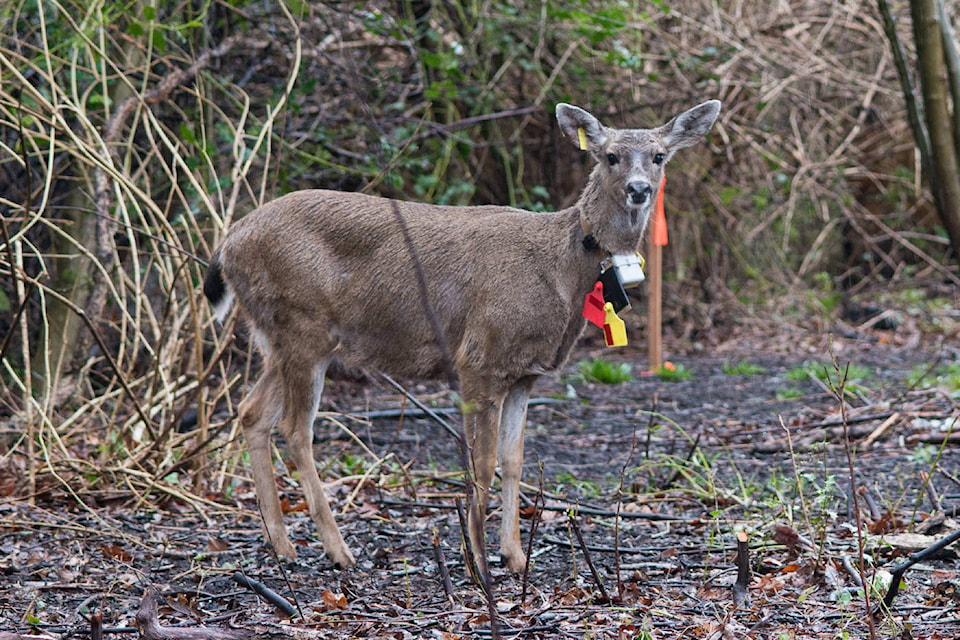With fawning season and the long days of summer upon us, deer are once again more visible than in the winter. This can be vexatious for some gardeners, while the defensive stance of a protective doe – likely with a fawn tucked away nearby – can be interpreted as intimidating by others. However it’s important to remember that this watchful deer behaviour is only meant to protect their young (an estimated 70% of whom won’t survive the winter) and is specific to the fawning season.
In fact, deer see people walking a dog as the aggressors. According to a recent CBC analysis of human-wildlife conflict across BC in the past two years, out of 406 calls to the Province about deer considered to be “aggressive”, the vast majority came from the Interior (11 were from Oak Bay) and only nine resulted in human injury (none in Victoria), all when owners put themselves between their dogs and the deer. By comparison, raccoons accounted for 17 human injuries.
It should be noted that deer in the Interior are mainly mule deer, who actually can be aggressive – the Columbian Black Tailed deer indigenous to Vancouver Island are not. With understanding deer behaviour and taking a few simple steps such as crossing the street, changing your route, not shouting or waving your arms, keeping your dog controlled on a short leash, and slowing down when driving, most human-deer conflict can be avoided.
Still, as municipal election time approaches, we begin to hear a call from some residents to “do something”. That “something” is already well underway, including an immuno-contraception program to reduce the deer population in Oak Bay that begins next month, pending the approval of provincial permits.
In late 2016, Oak Bay applied to the Province for funding through a cost-shared urban deer management program. As a result of this application, prepared by the Urban Wildlife Stewardship Society on behalf of the District, a multi-year program has been implemented. It’s funded by the Province, Oak Bay, and donations from UWSS supporters. It’s led by wildlife biologists and a wildlife veterinarian, and its methods have undergone rigorous review and meet regulations put in place by the Canadian Council on Animal Care and BC Fish and Wildlife. It’s also endorsed by the BCSPCA.
This spring, 20 does received GPS collars – a standard research tool for wildlife studies worldwide - which for two years will transmit their locations via satellite to researchers. Strategically placed wildlife field cameras are providing photographic evidence, and the combined data will determine population dynamics, movement, density, space use and trends.
This preliminary research is required by the Province. It’s also a vital step in effectively managing urban deer populations - what a person sees in one part of Oak Bay may not be what others see elsewhere. Oak Bay needs the big picture for effective management, and without knowing more about urban deer ecology, wildlife biologists assert that any deer reduction would function like an ineffective “folk remedy” - not a solution.
In September, an immuno-contraceptive vaccine will be administered to some of the uncollared Oak Bay does, with a booster administered a few weeks later prior to the rutting season. A coloured tag will be fixed to the deer’s ear along with a provincial tag and these deer will also be tracked and data collected. The idea is to reduce and stabilize the deer population by cutting the birth rate, and without opening up space for deer from surrounding populations to simply move in.
Oak Bay has learned a great deal about deer management over the last three years, including that culls don’t work - Cranbrook culled 4 out of 5 years and has 36 per cent more deer than when it started. The Province has stepped up to the plate with the cost-share program. With the help of the non-profit UWSS, a thoughtful, science based, cost-effective, humane solution that is in line with Oak Bay community values is being undertaken.
With this plan in place, Council candidates can focus on other important issues in this fall’s election.
Kristy Kilpatrick is the president of the Urban Wildlife Stewardship Society, an Oak Bay-based not-for-profit organization currently working with the municipalities of Oak Bay and Esquimalt on effective and humane approaches to urban deer management. She is a dog-owner, gardener and grandparent.
